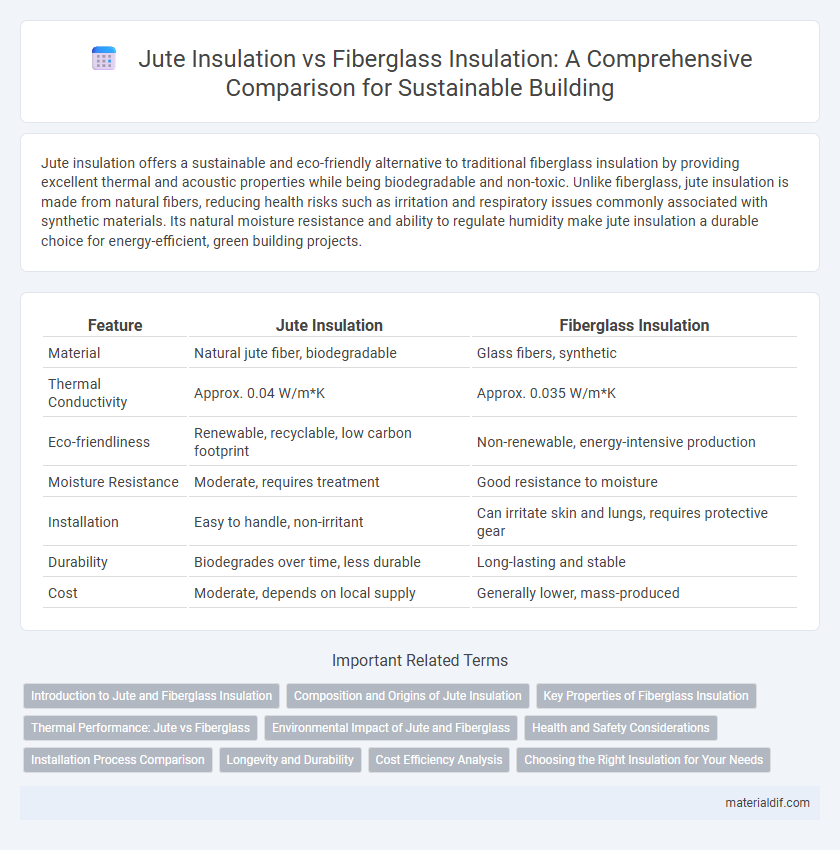Jute insulation offers a sustainable and eco-friendly alternative to traditional fiberglass insulation by providing excellent thermal and acoustic properties while being biodegradable and non-toxic. Unlike fiberglass, jute insulation is made from natural fibers, reducing health risks such as irritation and respiratory issues commonly associated with synthetic materials. Its natural moisture resistance and ability to regulate humidity make jute insulation a durable choice for energy-efficient, green building projects.
Table of Comparison
| Feature | Jute Insulation | Fiberglass Insulation |
|---|---|---|
| Material | Natural jute fiber, biodegradable | Glass fibers, synthetic |
| Thermal Conductivity | Approx. 0.04 W/m*K | Approx. 0.035 W/m*K |
| Eco-friendliness | Renewable, recyclable, low carbon footprint | Non-renewable, energy-intensive production |
| Moisture Resistance | Moderate, requires treatment | Good resistance to moisture |
| Installation | Easy to handle, non-irritant | Can irritate skin and lungs, requires protective gear |
| Durability | Biodegrades over time, less durable | Long-lasting and stable |
| Cost | Moderate, depends on local supply | Generally lower, mass-produced |
Introduction to Jute and Fiberglass Insulation
Jute insulation is a natural, eco-friendly material derived from the fibers of the jute plant, offering excellent thermal and acoustic properties while being biodegradable and sustainable. Fiberglass insulation consists of fine glass fibers and is widely used for its high thermal resistance, fire retardancy, and affordability despite being less environmentally friendly. Both materials serve as effective insulation solutions, with jute emphasizing environmental benefits and fiberglass prioritizing performance and cost efficiency.
Composition and Origins of Jute Insulation
Jute insulation is made from natural plant fibers derived from the jute plant, primarily grown in Bangladesh and India, offering a renewable and biodegradable alternative to synthetic materials. Unlike fiberglass insulation, which is composed of fine glass fibers produced from sand and recycled glass, jute insulation harnesses natural cellulose for thermal and acoustic properties. The organic composition of jute insulation contributes to better indoor air quality by minimizing chemical emissions compared to fiberglass options.
Key Properties of Fiberglass Insulation
Fiberglass insulation is composed of fine glass fibers that provide excellent thermal resistance and soundproofing capabilities, making it highly efficient for energy savings. It is non-combustible, moisture-resistant, and offers high durability, ensuring long-term performance in various environmental conditions. This insulation type also boasts widespread availability, cost-effectiveness, and easy installation, solidifying its position as a popular choice in residential and commercial construction.
Thermal Performance: Jute vs Fiberglass
Jute insulation offers comparable thermal performance to fiberglass insulation, providing effective heat retention with an R-value typically around 3.0 to 3.5 per inch thickness. Natural jute fibers exhibit low thermal conductivity, making them efficient at reducing heat transfer and maintaining indoor temperature stability. Unlike fiberglass, jute is biodegradable and less prone to moisture accumulation, which can enhance long-term thermal efficiency in humid environments.
Environmental Impact of Jute and Fiberglass
Jute insulation offers a sustainable alternative to fiberglass insulation due to its biodegradable nature and lower carbon footprint during production. Unlike fiberglass, which relies on energy-intensive manufacturing and contains non-renewable materials, jute insulation utilizes renewable plant fibers, reducing environmental pollution and waste. The cultivation of jute also enhances soil health and supports eco-friendly farming practices, making it a greener choice for insulation applications.
Health and Safety Considerations
Jute insulation offers a natural, non-toxic alternative to fiberglass insulation, reducing the risk of respiratory irritation and skin allergies commonly associated with fiberglass particles. Its biodegradability and absence of chemical binders contribute to improved indoor air quality and safer handling during installation. Fiberglass insulation, while effective, poses potential health hazards due to airborne glass fibers and requires protective equipment to minimize exposure.
Installation Process Comparison
Jute insulation offers a straightforward installation process, often requiring fewer protective measures due to its natural, non-toxic fibers, making it safer to handle compared to fiberglass insulation, which necessitates protective clothing and masks to avoid irritation from synthetic glass fibers. While fiberglass insulation involves cutting batts or rolls to fit spaces precisely, jute insulation can be easily cut and shaped with basic tools, reducing labor time and complexity. The biodegradable nature of jute also allows for simpler disposal and less environmental impact during installation cleanup compared to fiberglass.
Longevity and Durability
Jute insulation offers superior longevity compared to fiberglass insulation due to its natural resistance to moisture, mold, and pests, which enhances its durability in various environmental conditions. Unlike fiberglass, which can degrade and lose insulating properties over time when exposed to humidity or physical damage, jute maintains its structural integrity and thermal efficiency for decades. The eco-friendly characteristics of jute also contribute to its sustainable durability, making it a resilient alternative for long-term insulation solutions.
Cost Efficiency Analysis
Jute insulation offers a cost-efficient alternative to fiberglass insulation, with lower initial material costs and reduced installation expenses due to its lightweight and easy-to-handle properties. Over time, jute's natural durability and biodegradability contribute to decreased disposal fees and environmental impact, enhancing overall cost savings. Despite fiberglass having a marginally lower thermal conductivity, jute's affordability and potential for government subsidies in sustainable building projects make it a financially advantageous choice for eco-conscious builders.
Choosing the Right Insulation for Your Needs
Jute insulation offers a natural, sustainable alternative to fiberglass insulation, providing excellent thermal and acoustic properties with minimal environmental impact. Fiberglass insulation delivers higher R-values and is widely available, making it suitable for projects requiring cost-effective, high-performance thermal resistance. Selecting the right insulation depends on factors like environmental priorities, budget constraints, and the specific thermal and moisture conditions of your building project.
Jute Insulation vs Fiberglass Insulation Infographic

 materialdif.com
materialdif.com